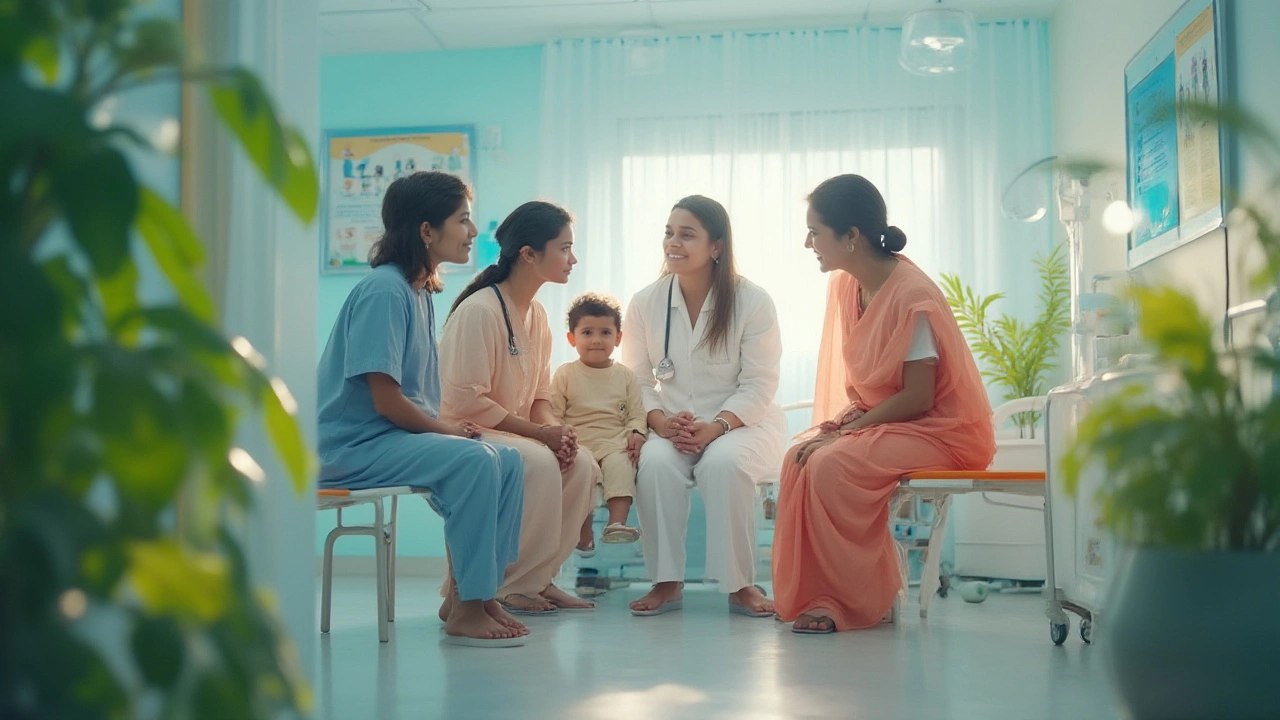
- Jul, 19 2025
- 0
Imagine living in a world where cancer is just a word, not a threat. For decades, people have wondered—can cancer ever be completely wiped out from the body? The web is full of quick answers, shocking stories, and promises that feel too good to be true. But when it comes to the idea of a cancer cure, it’s a bit more complicated—and a whole lot more interesting—than those clickbait headlines will tell you.
What Does '100% Curable' Even Mean?
The phrase '100% curable cancer' sounds hopeful, but it's a tricky one. In the medical world, 'cure' and 'remission' aren't the same thing. When doctors say a cancer is cured, they typically mean a person has survived several years (often five or more) after treatment with no sign of the disease, and the odds of it coming back are extremely low. Still, that doesn’t guarantee zero chance forever. Why? Because cancer is sneaky and can sometimes show up years later, even after a clean bill of health. That tiny risk makes doctors wary of the word 'cure.' They prefer 'remission,' which means there’s no evidence of disease, but they still keep watching.
This difference matters because it shapes a lot of what we hear about cancer 'cures.' Mixing up remission and cure can lead to false hope or unnecessary fear. While some cancers have high rates of cure with current treatments—think over 90% survival after five years—few get the official stamp of '100% curable' by the medical community. So what comes closest?
The most famous contenders are testicular cancer, thyroid cancer, and Hodgkin lymphoma. These cancers, caught early, often respond so well to treatment that doctors confidently talk about 'cure.' For example, the cure rate for testicular cancer can reach 98% for early stages, and certain types of thyroid cancer are famous for survival rates over 97%. But even here, doctors stay cautious—no one wants to make promises they can’t keep.
Curability also depends on several things, like how fast a cancer grows, how easy it is to spot, and how it reacts to chemo, surgery, or radiation. Some skin cancers, such as basal cell carcinoma, get removed with a simple surgery and almost never come back, making them another prime example. On the other hand, cancers like pancreatic or lung usually get a bad rap for being 'incurable,' mainly because they're caught too late.
Here's an eye-opener: several childhood cancers actually have higher rates of long-term cure than many adult cancers. For instance, acute lymphoblastic leukemia (ALL) in children can be cured in over 85% of cases. That's not just a number—it's thousands of kids every year going on to live long, full lives. Yes, some late effects can show up from the harsh treatments, but the odds are still stacked way higher in favor of cure than many people realize.
So, is there a chart of curability? You bet. Here’s a quick look at some well-documented five-year survival rates for curable cancers:
| Cancer Type | Five-Year Survival Rate (%) |
|---|---|
| Testicular Cancer | 98 |
| Thyroid Cancer | 98 |
| Hodgkin Lymphoma | 89 |
| Basal Cell Carcinoma (Skin) | >99 |
| Childhood Acute Lymphoblastic Leukemia (ALL) | 85 |
See those numbers? For some cancers, modern medicine is seriously impressive. But there's always that small chance of recurrence, and that's why even these sky-high survival rates fall just short of a technical '100% cure.'

Spotting Curable Cancers: Which Ones Make the List?
So, what sets these 'curable' cancers apart? Early detection is a huge part of the story. Cancers that show obvious symptoms quickly—like a lump you can feel or a weird mole—are more likely to get picked up early. Early-stage cancers often haven’t spread. The sooner treatment starts, the better the chances they never come back.
Take testicular cancer. It often shows up as a painless lump, which is easy to find (if you know to check). Thanks to this, and how well the cancer responds to chemo, the cure rates are sky-high. As an example, Lance Armstrong survived advanced testicular cancer, even after it had spread, because of aggressive treatment—and so have many regular guys without his fame or resources.
Basal cell carcinoma offers another simple story. This common skin cancer grows so slowly and rarely spreads that cutting it out in a dermatologist’s office almost always does the trick. Odds of it coming back are next to zero—just watch those sunny days and use sunscreen to avoid a repeat.
Then there’s Hodgkin lymphoma, which affects the immune system. In the 1950s, almost everyone diagnosed with it died within a few years. But today, thanks to combination chemo and sometimes radiation, nearly 9 out of 10 people are still around – and thriving – five years or more later. For those under 40, the cure rates are even better.
But here's where things get interesting. Leukemias and lymphomas that show up in children—like ALL—do way better than their adult versions. Kids’ bodies seem to handle chemo with extra resilience, and newer treatments keep pushing survival stats upward. So childhood cancer, once a terrifying word, has become a story of hope and even triumph for many families.
Doctors also pay attention to something called 'stage.' Stage 1 means the cancer is small and hasn’t spread. Cancers caught at stage 1—like colon, breast, and prostate—can have cure rates soaring into the 90% range, but the numbers plummet once they spread. That’s why everyone hammers the message about checkups, screenings, and knowing your body well enough to catch stuff early.
Thyroid cancers are another interesting group. These tumors often show up as harmless-looking lumps in the neck, and they tend to be slow-growing. Treatments like surgery, radioactive iodine, or both wipe out the cancer in most cases. For papillary thyroid cancer, the rate of surviving more than five years with no recurrence is close to 98%—pretty wild, right?
But let’s clear up a hard truth. There’s no 'one size fits all' in cancer. Even the 'curable' ones can come back, and sometimes aggressive cancers slip through the cracks. Genetics play a role, as does access to the latest treatments. A curable cancer in a city with top hospitals might be riskier for someone in a rural clinic with fewer resources or less awareness.
It’s tempting to want a list: these ones are curable, these aren’t—but medicine just doesn’t work that way. Pay attention to your own risk factors and family history, and don’t shrug off things that seem weird for your body. The odds can be in your favor if you catch things quickly and get the right help early.

How to Boost Your Chances: Tips, Myths, and What the Future Holds
If you or someone you care about is facing cancer, hearing that some types are '100% curable' sounds like magic. While there’s no magic bullet for every single case, you can definitely shift the odds with a few smart moves. So what helps tilt things to the curable side?
First, stick to screening schedules. That means the regular Pap smears, mammograms, colonoscopies, skin checks—don’t blow them off. People love to avoid doctors, but these tests catch things before they're a problem, often at exactly the stage when your odds are best.
Second, lifestyle isn’t just a buzzword. If your parents or siblings have had certain cancers, ask a doctor about genetic testing. People with a known higher risk sometimes start screening earlier or do extra tests. It can feel scary to know you’re 'at risk,' but knowledge lets you act fast if something shows up.
Diet, exercise, and skipping tobacco still win for everyday prevention. For example: quitting smoking slashes your risk for not just lung cancer but several other types, too. Keeping a healthy weight and a diet rich in fruits and veggies can boost your immune system and lower inflammation, making your whole body less 'welcoming' to future troublemakers.
Don’t fall for miracle cures. Plenty of celebrities and influencers push herbal drinks, crystals, and superfoods. While eating berries never hurt anyone, there's no evidence these things alone cure cancer. If a 'cure' sounds too easy, it probably is. Stick with treatments backed by real evidence and research. Talk honestly with your doctor, and never skip prescribed medicine in favor of online fads.
Keep tabs on clinical trials too. Sometimes, the best chance at a true cure comes from joining one of these studies. Trials often offer new medicines or combinations that aren’t available everywhere yet. The best ones mix proven treatments with exciting new ideas, and patients who join often get watched super-closely—a win all around.
The numbers keep climbing as scientists learn more. In just the last fifteen years, survival rates for many cancers jumped thanks to breakthroughs in targeted therapy and immunotherapy. These aren’t your grandparents’ chemo—some of these new meds use the immune system to chase cancer cells, leaving healthy ones alone. The real hope? A future where 'cure' isn’t rare, but routine—even for tough cases.
Here’s the wildest part: dogs get cancer more than people do (about 25% of dogs), but some of the treatments developed for them are now helping us. Cancer research goes both ways, with doctors and vets working together to reverse-engineer the most effective cures.
Don’t put off that checkup, don’t freak out over every internet stat, and if you’re worried about your risk, ask a real expert. Cancer might be scary, but knowledge, early action, and modern medicine make a bigger difference than most people imagine. In some cases, '100% curable' is closer than you think—it just doesn’t come with a magic guarantee stamp.
Nikhil Verma
I'm a dedicated physician with a passion for exploring the intricacies of medicine, focusing on the unique healthcare challenges in India. I spend much of my spare time writing articles aimed at improving public understanding of health issues. Balancing my clinical practice and writing allows me to reach a wider audience, sharing insights and fostering a deeper appreciation for medical advancements. I derive immense satisfaction from both treating patients and engaging with readers through my writing.